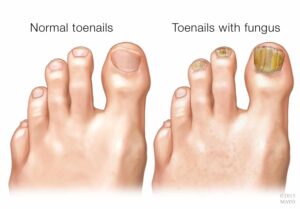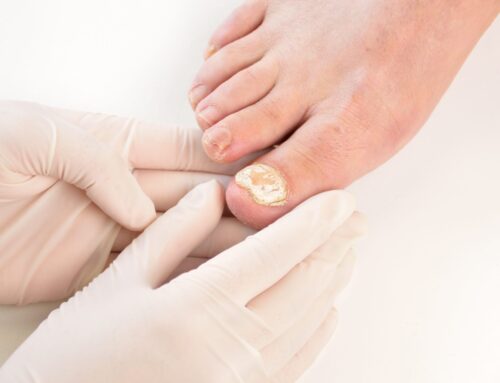To groom and soften hard fungal toenails is often very difficult. Many of the symptoms that toenail fungus causes can make this task more difficult than for other people who aren’t infected. Toenail fungus symptoms are usually solely an aesthetic issue, which only causes a difference in how the toenail looks.
However, there are many issues that toenail fungus can cause as well. These tend to be more frustrating to deal with. Many of those with fungal infections struggle with feeling like their nails are too hard or thick to cut. Regular grooming and hygiene of the nail and toe can become severely impacted by these functional changes. The resulting overgrowth of the nail can make the nail’s aesthetic even worse as the nail grows excessively long.
Hard Nails
Hard fungal nails are one of many symptoms of toenail fungus. Normal, healthy nails should have no issues being trimmed or groomed. These nails are normally associated with a particular look, and anything deviating from it could indicate that something is wrong. Nails that are in good health will appear clear. The nail reveals the pink or brown skin that lies underneath it.
A healthy nail will not be excessively thick, brittle, or detached from the nail bed at all. A healthy nail also won’t have debris buildup under the nail, cracking on the surface of the nail, or any other sort of damage that is visible. Additionally, the nail should grow at a reasonable rate. It should have enough structure to stay intact, but still be soft enough to trim without problems.
Symptoms of Toenail Fungus
Hard fungal nails are just one of many symptoms of toenail fungus that should be monitored. Discoloration, or a change in the color of the nail, is usually one of the most common and first to appear symptoms of a fungus. The first signs of this change in the nail’s color will usually start as a small dot or stripe on the surface of the toenail. As the toenail fungus infection continues without being treated effectively, the discoloration under the nail can grow to cover a larger portion of the nail.
When the fungus is left untreated for a long period of time, the entire nail will often become covered in the color. Other visible aesthetic damages can happen to the nail aside from discoloration. Some other common symptoms of a toenail fungus infection include nail brittleness, cracking, and detachment from the nail bed.
Some of the most frustrating changes toenail fungus can cause include the thickening and hardening of the nail. These symptoms pose a unique concern as they can definitely affect your ability to groom and soften hard fungal toenails to maintain proper hygiene of the nails effectively. When the grooming of the nails is affected, it is necessary to take other measures to trim the nails regularly.
Nail fungus damage
Normally, fungal damage to the toe is cosmetic. Nails typically become discolored, usually starting as a spot or stripe that grows to affect more of the nail’s surface. As the fungus grows, it can also cause changes in the texture and composition of the nail. Damage from toenail fungus can lead to debris buildup under the nail. Cracking, brittleness, thickening, and hardening of the nail are also common. While these issues are cosmetic in nature, sometimes the changes in the texture and composition of the nail can have functional consequences as well. For example, when the nail becomes especially brittle or hard, cutting the nail with clippers can be difficult.
Why is nail trimming difficult when infected with fungus?
Grooming and softening fungal nails are essential for maintenance. Unfortunately, the condition of the fungal toenails can make regular grooming of the nails impossible. When nails are thick or hard from a fungus, it can be impossible to even get your nail clippers to fit around the nail. Thickened nails are also more difficult to cut mechanically. This is due to the nail clippers having to be able to shear through a larger number of nails. Also, the nail fungus can cause the toenails to become harder than normal. Even if the toenail is as thin as it is while healthy, nails that are hardened because of fungus can still be more difficult to cut.
How to Groom and Soften
Hard fungal nails will need to be trimmed frequently to maintain a good hygiene level. Extremely long nails from an overgrowth of the toenail can be problematic for overall health. One problem is that overgrown toenails can harbor bacteria under them that can lead to other infections. Extremely long toenails significantly increase the risk of forming ingrown toenails.
Long toenails break very easily, and broken toenails tend to have jagged, rough edges that tear into the skin of the toe easily. Long toenails can also be personally uncomfortable and push up against the shoe as you walk and stand. Excessively long toenails will absolutely be detrimental to your toe and nail health down the line, so if you can’t trim your nails because of a fungal infection, you need to find alternatives, like softening the nail.
Softening thickened fungal nails is definitely important to be able to trim them. Trimming fungal nails can feel impossible for people to do because of the way toenail fungus has changed their nails. This is because the symptoms of toenail fungus can directly impact the simplicity of trimming the nails. When nails have become excessively thick, traditional home nail clippers often won’t even fit around them.
Sometimes, even medical-grade nail clippers won’t be able to trim these nails. The nail clippers have to slice through more nail material, which presents more resistance to the blades. Nails can become more hardened by a toenail fungus infection, which poses a different challenge. This means that even if the toenail is the same thickness as normal, the nail can still be more difficult to cut.
Softening of the nail might require multiple attempts
Softening fungal toenails sometimes requires more than just one session of soaking in warm water. In cases of severe toenail fungus infection, the nails may require multiple repeated sessions of this treatment before the nail is soft enough to cut. In this case, you should repeat the treatment daily until your nail is at the level of softness that you desire. If repeated soaks don’t improve the condition of your nail’s hardness, you can try to apply a nail softening cream after the water bath and let that soak in as well.
Softening fungal toenails isn’t always sufficient to trim the nails. Sometimes the nail is too thickened from fungus to fit between the blades of the nail clippers at all. In this case, the nail will need to be thinned down before being trimmed. This should not be done at home and can be done by a licensed podiatrist in a process called debridement.
Laser Treatment for Fungal Nails
For patients with hard fungal nails, letting the nail grow out may seem like the only option available. Sometimes getting nail clippers to trim the nail effectively can be impossible because the fungus can make the nails hard to cut through. Even if the fungus isn’t making the nail harder, the nail can still become thickened because of toenail fungus. Nail clippers may not even fit over nails that have become excessively thick.
While soaking the feet is helpful to groom and soften hard fungal toenails, the best thing to do in this situation is to be seen by a nail doctor. They will be able to provide effective care for the fungus, and hopefully treat the fungal infection itself once and for all. To learn more about this treatment or schedule a free consultation with a nail doctor, give us a call at 1-(800) 672-0625 or visit our website for more information.






